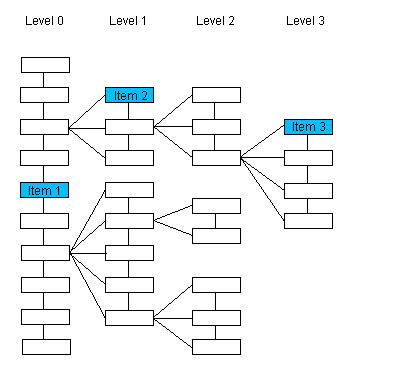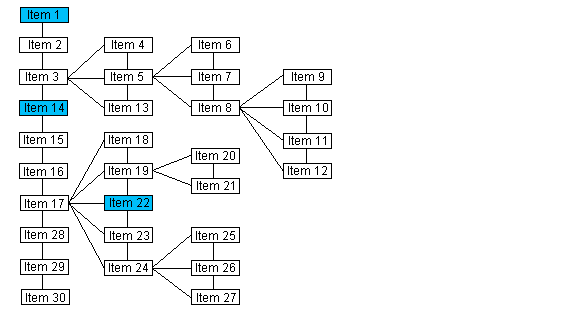FindFirstElement Method
Returns the first item in the Data Set with the specified Tag.
public DicomElement FindFirstElement(DicomElement element,long tag,bool tree)
Public Function FindFirstElement( _ByVal element As DicomElement, _ByVal tag As Long, _ByVal tree As Boolean _) As DicomElement
public:DicomElement^ FindFirstElement(DicomElement^ element,int64 tag,bool tree)
Parameters
element
An item in the Data Set.
tag
Tag of the item to find.
tree
true to evaluate the Data Set as a tree; false to evaluate the Data Set as a list.
Return Value
The first item in the Data Set with the specified Tag, or a null reference (Nothing in VB) if an item with the specified Tag was not found.
For the sake of the following illustrations, the order of siblings is top to bottom. Therefore first is evaluated top to bottom. If the Data Set is evaluated as a tree structure, this method returns the first item on the same level as element with the same parent as element, that has Tag tag.
Please note that the numbering of the items of interest in this first illustration is arbitrary and does not imply order.

| If the passed object points to: | The method returns an object pointing to: |
|---|---|
| Item 1 | The first sibling (same level, same parent) of Item 1 that has Tag tag, if such an item exists. If such an item does not exist, the method returns null. |
| Item 2 | The first sibling (same level, same parent) of Item 2 that has Tag tag, if such an item exists. If such an item does not exist, the method returns null. |
| Item 3 | The first sibling (same level, same parent) of Item 3 that has Tag tag, if such an item exists. If such an item does not exist, the method returns null. |
If the Data Set is evaluated as a list, this method returns the first item in the entire list that has Tag tag. The search begins at the top of the list.
Please note that the numbering of the items in the following illustration does indicate the order of the items when the Data Set is evaluated as a list.

| If the passed object points to: | The method returns an object pointing to: |
|---|---|
| Item 1 | The first item in the list that has Tag tag, if such an item exists. Searching begins at the top of the list. If an item with Tag tag is not found, null is returned. |
| Item 14 | The first item in the list that has Tag tag, if such an item exists. Searching begins at the top of the list. If an item with Tag tag is not found, null is returned. |
| Item 22 | The first item in the list that has Tag tag, if such an item exists. Searching begins at the top of the list. If an item with Tag tag is not found, null is returned. |
The following methods will also help you find elements in the Data Set with a specific Tag:
The following methods will help you find specific modules in the Data Set:
Reference
© 1991-2020 Apryse Sofware Corp. All Rights Reserved.
